Unit 8 How do you make a banana milk shake?SectionB知识点学案
文档属性
| 名称 | Unit 8 How do you make a banana milk shake?SectionB知识点学案 |
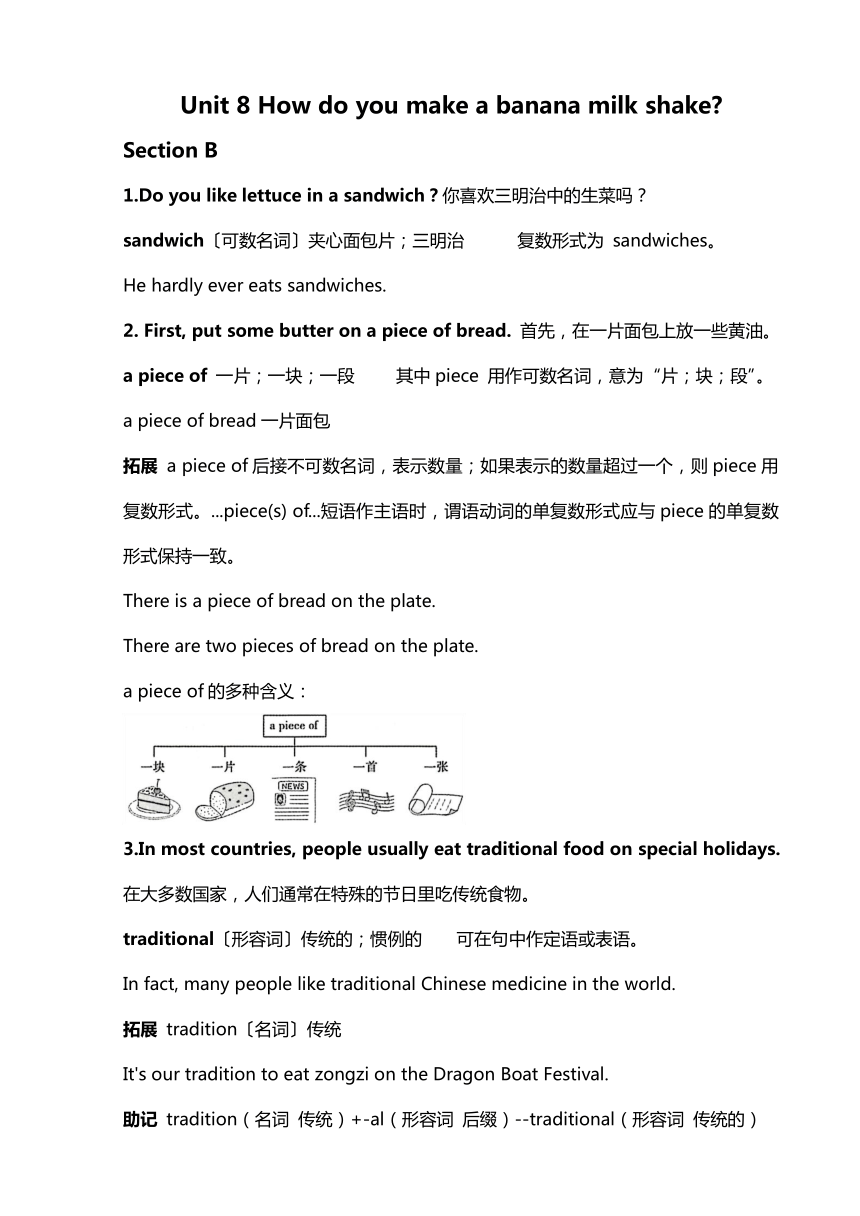
|
|
| 格式 | docx | ||
| 文件大小 | 616.0KB | ||
| 资源类型 | 教案 | ||
| 版本资源 | 人教新目标(Go for it)版 | ||
| 科目 | 英语 | ||
| 更新时间 | 2023-07-09 21:47:50 | ||
图片预览

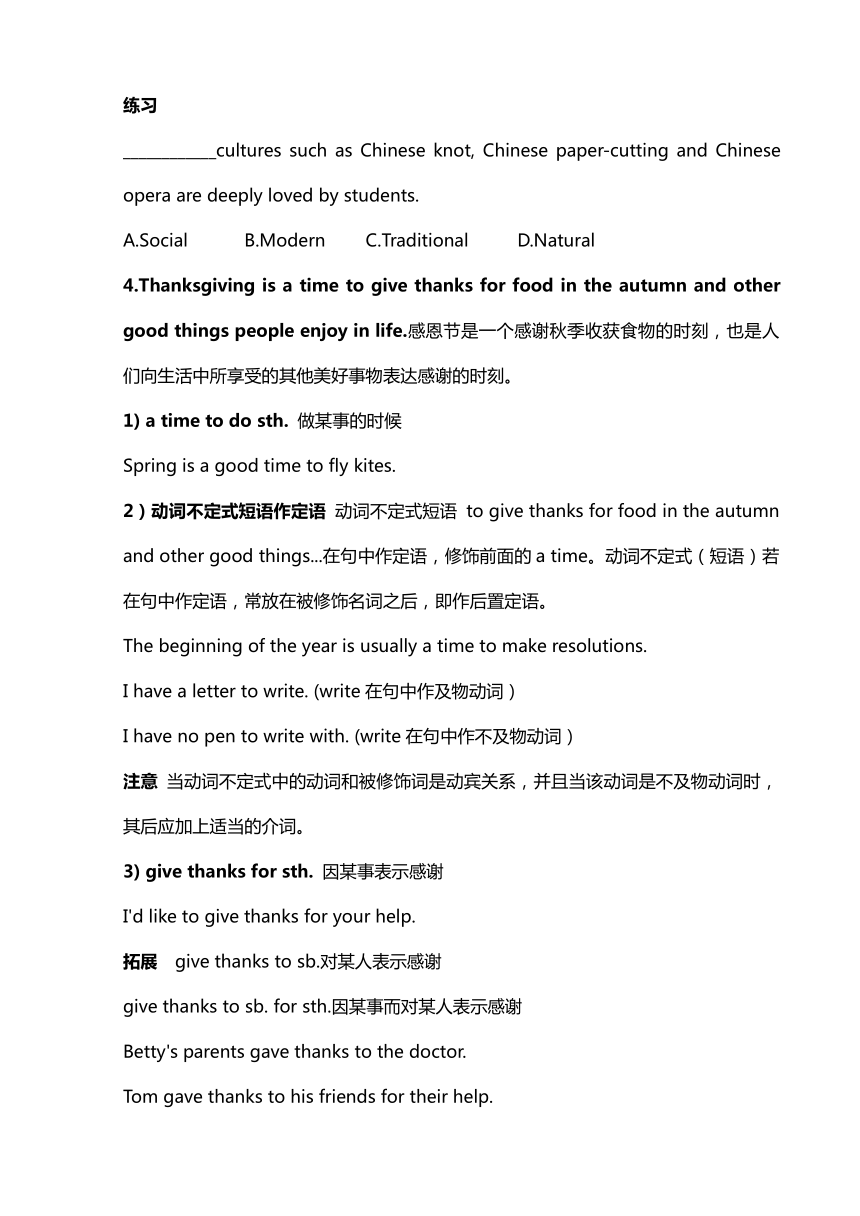
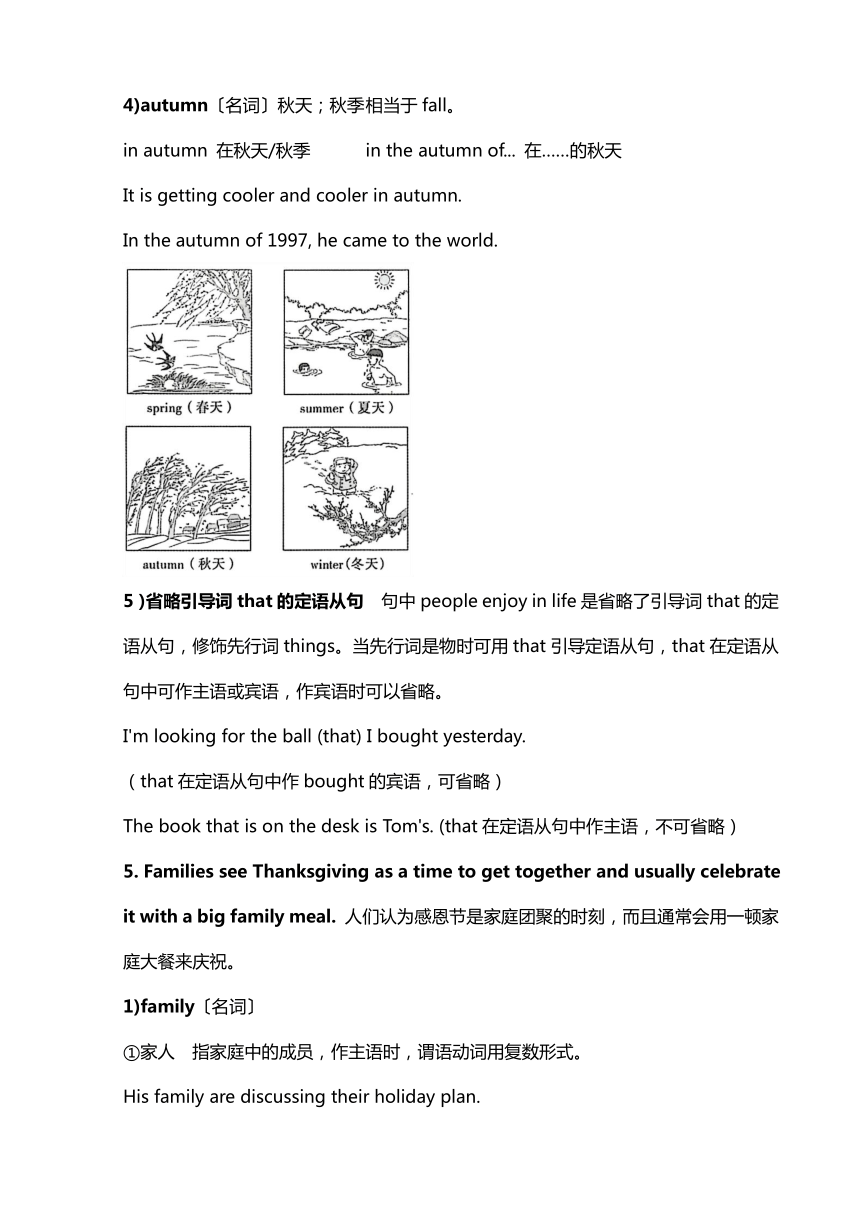
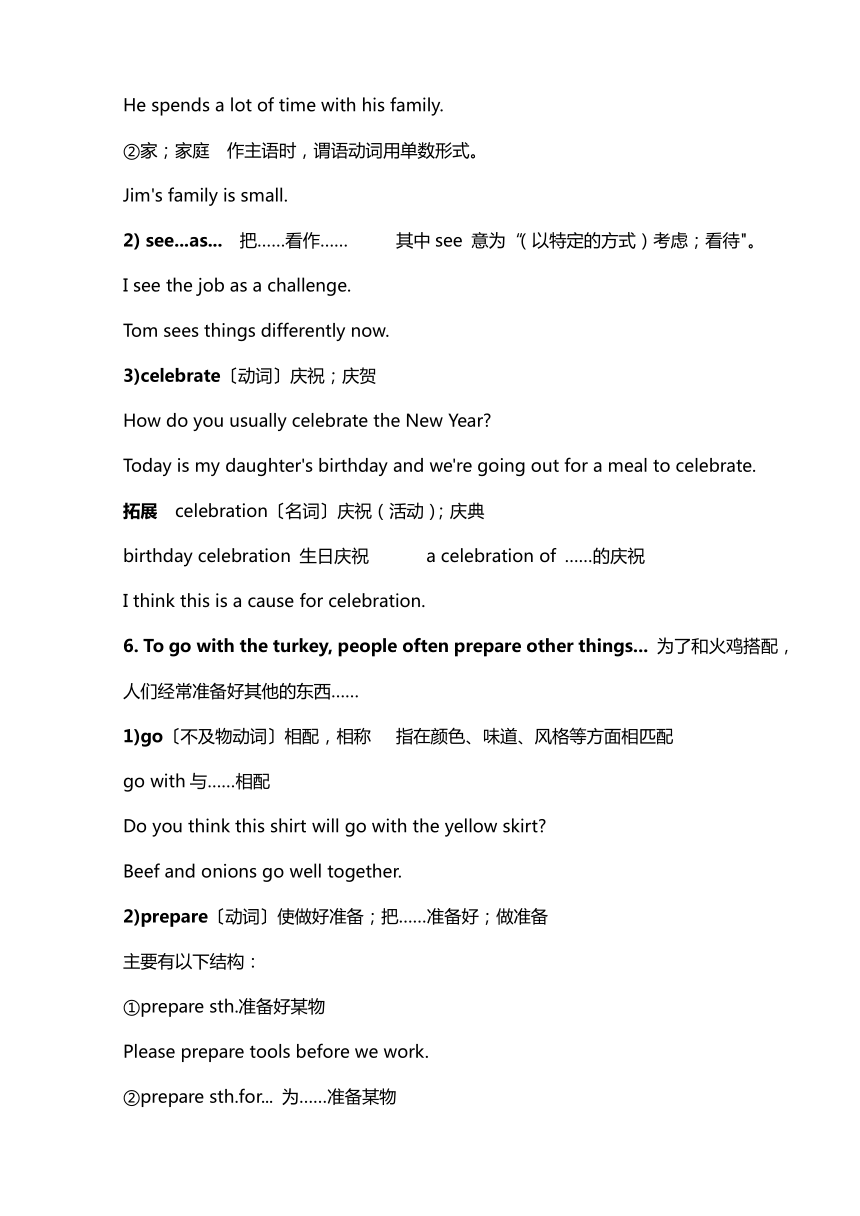
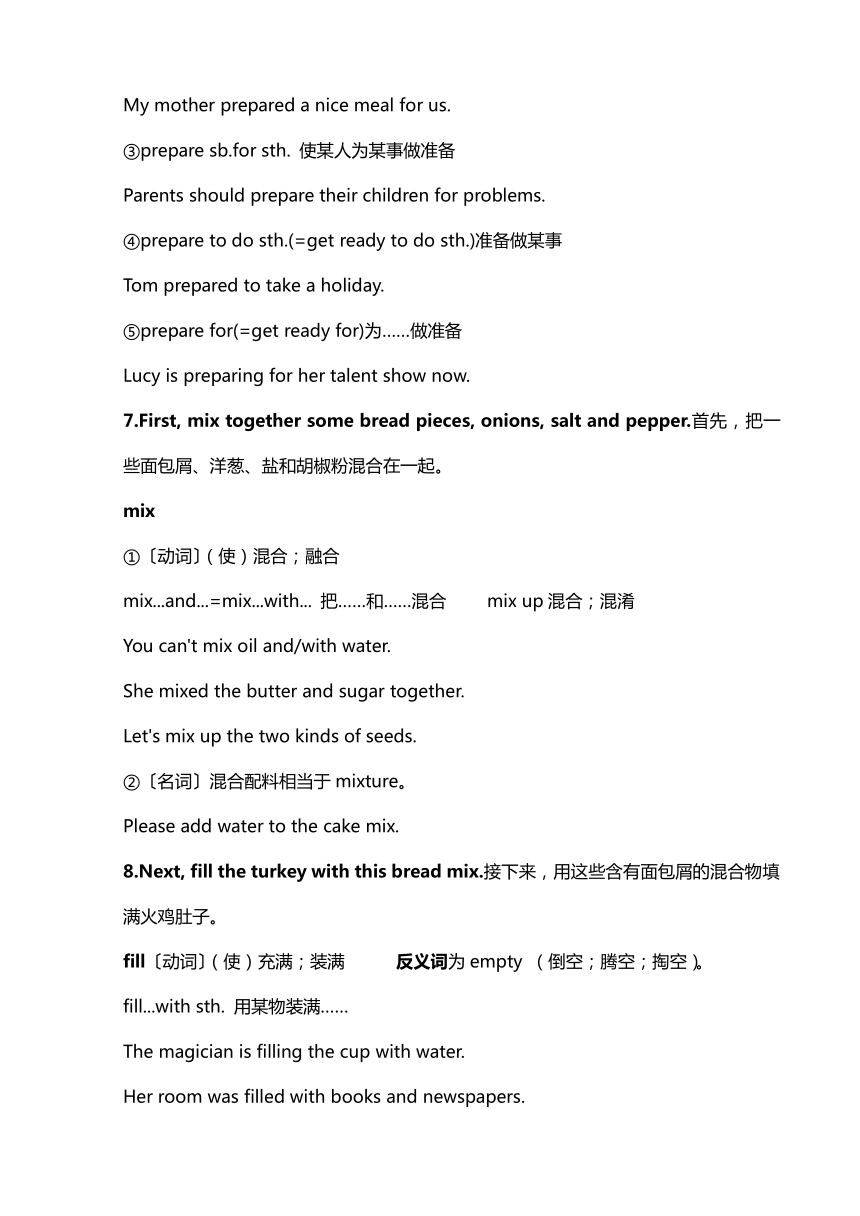
文档简介
Unit 8 How do you make a banana milk shake
Section B
1.Do you like lettuce in a sandwich?你喜欢三明治中的生菜吗?
sandwich〔可数名词〕夹心面包片;三明治 复数形式为 sandwiches。
He hardly ever eats sandwiches.
2. First, put some butter on a piece of bread. 首先,在一片面包上放一些黄油。
a piece of 一片;一块;一段 其中piece 用作可数名词,意为“片;块;段”。
a piece of bread一片面包
拓展 a piece of后接不可数名词,表示数量;如果表示的数量超过一个,则piece用复数形式。...piece(s) of...短语作主语时,谓语动词的单复数形式应与piece的单复数形式保持一致。
There is a piece of bread on the plate.
There are two pieces of bread on the plate.
a piece of的多种含义:
3.In most countries, people usually eat traditional food on special holidays.在大多数国家,人们通常在特殊的节日里吃传统食物。
traditional〔形容词〕传统的;惯例的 可在句中作定语或表语。
In fact, many people like traditional Chinese medicine in the world.
拓展 tradition〔名词〕传统
It's our tradition to eat zongzi on the Dragon Boat Festival.
助记 tradition(名词 传统)+-al(形容词 后缀)--traditional(形容词 传统的)
练习
____________cultures such as Chinese knot, Chinese paper-cutting and Chinese opera are deeply loved by students.
A.Social B.Modern C.Traditional D.Natural
4.Thanksgiving is a time to give thanks for food in the autumn and other good things people enjoy in life.感恩节是一个感谢秋季收获食物的时刻,也是人们向生活中所享受的其他美好事物表达感谢的时刻。
1) a time to do sth. 做某事的时候
Spring is a good time to fly kites.
2)动词不定式短语作定语 动词不定式短语 to give thanks for food in the autumn and other good things...在句中作定语,修饰前面的a time。动词不定式(短语)若在句中作定语,常放在被修饰名词之后,即作后置定语。
The beginning of the year is usually a time to make resolutions.
I have a letter to write. (write在句中作及物动词)
I have no pen to write with. (write在句中作不及物动词)
注意 当动词不定式中的动词和被修饰词是动宾关系,并且当该动词是不及物动词时,其后应加上适当的介词。
3) give thanks for sth. 因某事表示感谢
I'd like to give thanks for your help.
拓展 give thanks to sb.对某人表示感谢
give thanks to sb. for sth.因某事而对某人表示感谢
Betty's parents gave thanks to the doctor.
Tom gave thanks to his friends for their help.
4)autumn〔名词〕秋天;秋季 相当于fall。
in autumn 在秋天/秋季 in the autumn of... 在……的秋天
It is getting cooler and cooler in autumn.
In the autumn of 1997, he came to the world.
5)省略引导词that的定语从句 句中people enjoy in life是省略了引导词that的定语从句,修饰先行词things。当先行词是物时可用that引导定语从句,that在定语从句中可作主语或宾语,作宾语时可以省略。
I'm looking for the ball (that) I bought yesterday.
(that在定语从句中作bought的宾语,可省略)
The book that is on the desk is Tom's. (that在定语从句中作主语,不可省略)
5. Families see Thanksgiving as a time to get together and usually celebrate it with a big family meal. 人们认为感恩节是家庭团聚的时刻,而且通常会用一顿家庭大餐来庆祝。
1)family〔名词〕
①家人 指家庭中的成员,作主语时,谓语动词用复数形式。
His family are discussing their holiday plan.
He spends a lot of time with his family.
②家;家庭 作主语时,谓语动词用单数形式。
Jim's family is small.
2) see...as... 把……看作…… 其中see 意为“(以特定的方式)考虑;看待"。
I see the job as a challenge.
Tom sees things differently now.
3)celebrate〔动词〕庆祝;庆贺
How do you usually celebrate the New Year
Today is my daughter's birthday and we're going out for a meal to celebrate.
拓展 celebration〔名词〕庆祝(活动);庆典
birthday celebration 生日庆祝 a celebration of ……的庆祝
I think this is a cause for celebration.
6. To go with the turkey, people often prepare other things... 为了和火鸡搭配,人们经常准备好其他的东西……
1)go〔不及物动词〕相配,相称 指在颜色、味道、风格等方面相匹配
go with与……相配
Do you think this shirt will go with the yellow skirt
Beef and onions go well together.
2)prepare〔动词〕使做好准备;把……准备好;做准备
主要有以下结构:
①prepare sth.准备好某物
Please prepare tools before we work.
②prepare sth.for... 为……准备某物
My mother prepared a nice meal for us.
③prepare sb.for sth. 使某人为某事做准备
Parents should prepare their children for problems.
④prepare to do sth.(=get ready to do sth.)准备做某事
Tom prepared to take a holiday.
⑤prepare for(=get ready for)为……做准备
Lucy is preparing for her talent show now.
7.First, mix together some bread pieces, onions, salt and pepper.首先,把一些面包屑、洋葱、盐和胡椒粉混合在一起。
mix
①〔动词〕(使)混合;融合
mix...and...=mix...with... 把……和……混合 mix up混合;混淆
You can't mix oil and/with water.
She mixed the butter and sugar together.
Let's mix up the two kinds of seeds.
②〔名词〕混合配料相当于mixture。
Please add water to the cake mix.
8.Next, fill the turkey with this bread mix.接下来,用这些含有面包屑的混合物填满火鸡肚子。
fill〔动词〕(使)充满;装满 反义词为empty (倒空;腾空;掏空)。
fill...with sth. 用某物装满……
The magician is filling the cup with water.
Her room was filled with books and newspapers.
注意 be filled with是一个固定短语,也fill...with...的被动形式,意为“充满……;装满……”。
拓展 full〔形容词〕满的 反义词为empty (空的)。
be full of (=be filled with)充满……
The glass is full of honey.
9.When it is ready, place the turkey on a large plate and cover it with gravy.火鸡烤好后,把它放在一个大盘子上,浇上肉汁。
1) place
①〔及物动词〕放置;安置
He placed the machine under the table.
②〔可数名词〕地方;地点
a place of interest名胜
Qufu is an educational place.
Mr.Brown visits lots of places of interest in the world every year.
2) cover
①〔及物动词〕遮盖;覆盖
cover...with... 用……覆盖…… be covered with... 被……覆盖
5G networks cover many cities in China now.
Ann covered her face with her hands.
The mountain is covered with thick snow all year round.
②〔名词〕封面;覆盖物;盖子
The cover of the book is nice.
You can use a cover to cover the pan.
10...serve it to your friends with some vegetables.……用它配着一些蔬菜招待你的朋友。serve〔动词〕接待;服务;提供
serve sth. to sb.=serve sb.(with)sth 用某物招待某人
She served coffee to her friend. =She served her friend (with) coffee.
拓展 service〔名词〕服务;接待;侍候
The service in that hotel was good.
11.Then, cook it at a very high temperature for a long time.然后,以高温长时间烘烤。
temperature 〔名词〕
①温度
at a very high/low temperature以高温/低温;在高温/低温下
the temperature of ……的温度
The workers often work at a very high temperature.
The temperature of the water is just right for drinking.
②气温 对气温进行提问用what.
What was the temperature yesterday
③体温
take one's temperature量某人的体温
The nurse took my temperature just now.
12.To make this special food, you need to have rice noodles, chicken soup,chicken,lettuce and eggs.为了做这种特别的食物,你需要有米线、鸡汤、鸡肉、生菜和鸡蛋。
动词不定式短语作目的状语
to make this special food 在本句中作目的状语。动词不定式(短语)作目的状语时可以位于句首,常用逗号与后面的句子隔开,也可位于句末,意为“为了做某事”。
To pass the driving test, he practices again and again.
She studies harder to get good grades.
练习
Nancy didn't know anyone in the new school, so she decided to join an after-school club____________some new friends.
A.to meet B.meet C.me D.meets
13. Now, it's time to enjoy the rice noodles! 现在就是享用米线的时刻了!
It's time (for sb.)to do sth. 到(某人)做某事的时间了
It's time to make resolutions.
It's time for us to protect our environment.
注意 for后如果是人称代词,要用其宾格形式。
拓展 It's time for sth. 到(做)某事的时间了。 for是介词,后常接名词或代词。
"It's time for sth."有时可与"It's time to do sth."进行同义句转换。
It's time for dinner. =It's time to have dinner.
知识梳理
用法集萃
1.let sb.do sth.让某人做某事 2.want (sb.)to do sth.想要(某人)做某事
3.forget to do sth.忘记要做某事(事情未做)forget doing sth忘记做过某事(事情已做)
4.need to do sth.需要做某事 need doing sth.某事需要被做
5.how to do sth.如何做某事 6.make+宾语+形容词 使……怎么样
7.a time to do sth.做某事的时候
8.one/a way to do sth.做某事的一个方法 one/a way of doing sth.做某事的一个方法
9.How many+可数名词复数... 多少…… 10.How much+不可数名词... 多少……
11. What are the reasons for (doing) sth. (做)某事的理由是什么?
12. It’s time (for sb.)+to do sth.到(某人)做某事的时候了。
13. First...Next...Then...Finally... 首先……接下来……然后……最后……
14.Here is one way to do sth.这是做某事的一种方法。
语法专项
一 祈使句
在英语中,用于表达命令、请求、劝告、警告、禁止等的句子叫祈使句。祈使句通常省略主语(you), 句首动词用原形。祈使句一般没有时态的变化,也不能与情态动词连用。
1.祈使句的肯定形式
类型 主要结构 例句
Do型 动词原形(+宾语)... Add some water.
Be型 Be+表语... Be careful!
Let型 Let+宾语+动词原形... Let me read the letter for you.
注意:为了表示委婉的语气可以在句首或句尾加上please,加在句尾时,用逗号和前面隔开。
Sit down, please!
2.祈使句的否定形式
(1)Don't+动词原形(+其他).
Don't go out at night.
Don't be careless.
(2)Never+动词原形(+其他).
Never be late again!
(3)Let型祈使句的否定形式,表示命令时通常在句首加don't,表示请求或建议时通常在宾语后、动词原形前加not.
Don't let them go.
Let's not talk about it.
(4)No+v.-ing/n.
No smoking.禁止吸烟 No photos.禁止拍照。
3.祈使句的强调形式
(1)有时为了加强语气,可在句首加助动词do。
Do tell me the truth!
(2)有时为了明确地向对方提出请求或发出命令,可加上称呼语,或把省略的you表示出来。
Turn off the light, Tom!
4.祈使句的反意疑问句
(1)肯定形式的祈使句,表示请求时附加问句通常用will you;表示劝说、邀请时附加问句常用won't you。
Please call us soon, will you
Come to live with us, won't you
(2)否定形式的祈使句,附加问句通常用will you。
Don't go out alone at night, will you
(3)let us开头的祈使句,附加问句通常用will you;但 let's开头的祈使句,附加问句要用 shall we。
Let us have a rest, will you
Let's play the piano after school, shall we
助记 祈使句的用法
新使句表命令,还表请求或建议。动词原形放句首,主语是 you常省去。
don't置前表否定,let 否定有两种。想要客气加 please, do 置开头强语气
练习
(1)—____________silent, please! You are in the library.
—I'm sorry, madam.
A.Keep B.To keep C.Keeping D.Kept
(2)—Sam,____________run in the hallways. It's very dangerous.
—Sorry,Ms.Black.
A.do B,don't C.not D.doesn't
二 可数名词与不可数名词
从名词所表示的事物的性质来看,名词分为可数名词和不可数名词两类。
1.分辨可数名词和不可数名词
(1)可数名词有单数和复数两种形式,而不可数名词没有复数形式。
pen→pens 钢笔 bread 面包
(2)不定冠词、基数词可直接修饰可数名词,表示数量;而不可数名词的量用“冠词/基数词+表示计量单位的名词+of+不可数名词"结构表示。
an apple 一个苹果 two photos 两张照片
a piece of bread一片面包 four cups of water 四杯水
(3)可数名词复数前可用many, some,any,few,a few等修饰;不可数名词前可用much,some,any,little,a little等修饰。
many teachers许多教师 much money 许多钱
some books 一些书 some juice 一些果汁
(4)提问可数名词的数量用how many,提问不可数名词的量用how much。
How many flowers do you have
How much bread do we need
(5)可数名词作主语时,谓语动词的数要与主语的单复数保持一致;不可数名词作主语时,谓语动词用单数。
One apple is enough.
Bananas are necessary for a banana milk shake.
Money is very important, but it is not everything.
注意 “冠词/基数词+表示计量单位的名词+of+ 不可数名词"结构作主语时,谓语动词的数要与表示计量单位的名词的单复数一致。
A teaspoon of honey is not enough. Three teaspoons of it are just right.
2.可数名词的复数形式
可数名词复数形式的变化有规则变化和不规则变化两种。
(1)规则变化
名词复数的构成,通常是在单数形式后面加-s或-es.其具体方法如下:
情况 构成方法 读音 例词
一般情况 加-s 清辅音后读/s/;浊辅音和元音后读/z/;在/s,/z/, /tf/,/d / 等后读/iz/ book—books书 dog—dogs狗
以s,x,ch,sh结尾的大多数名词 加-es class—classes班级 watch—watches手表
以辅音字母加y结尾的名词 变y为i, 再加-es city—cities城市 baby—babies婴儿 factory—factories工厂
以f(e)结尾的名词 变f(e)为v,再加-es wife—wives妻子 half—halves一半 leaf—leaves树叶
助记 名词复数的规则变化
名词单数变复数,直接加-s的占多数。s,x,ch,sh 来结尾,直接加上-es。
辅音字母加上y,要变y为i,再把-es添。词尾若是f/fe,加-es之前要用v换。
拓展 以字母o结尾的名词变复数形式时有的加-es;有的加-s。
potato—potatoes 土豆 tomato—tomatoes 西红柿
radio—radios收音机 photo—photos 照片
助记 以-o结尾复数形式加-es的名词
英雄(hero)爱吃西红柿(tomato)和土豆(potato), 真有意思(-es)
(2)不规则变化
①改变单数名词中的元音字母。
man→men 男人 woman →women 女人 goose→geese 鹅
foot→feet足 tooth → teeth 牙齿
助记 男人女人a变e,鹅、足、牙oo变ee。
②词尾有变化。child→children 孩子
③单数、复数形式相同。
sheep→ sheep绵羊 deer→deer 鹿 Chinese→Chinese 中国人
(3)通常情况下,当一个名词作定语修饰另一个名词时,其复数形式只需将中心名词变为复数形式。但当man或woman 修饰另一个名词时,变复数要将中心名词及man或woman都变成复数。
a girl student→girl students 女学生 a man driver→men drivers 男司机
练习
(1)—How much____________do you need
—We need two cups.
A.milk B.egg C.pear D.potato
(2)Alisa will pick strawberries and____________ (tomato) with her father tomorrow.
语法专练
1.____________it over, and you will be able to work out the problem.
A.Thinking B.To think C.Think
2.____________wake up your sister, Ben.She needs a good sleep.
A.Don't B.Doesn't C.Aren't D.Can't
3. Uncle Li has a farm;there are some____________on the farm.
A.chicken and sheer B.chickens and sheeps
C.chickens and sheep D.chicken and sheeps
4. There are many old____________and____________in the park.
A.man;children B.men;child C.men;children
5.—Would you like some____________?
—Yes,madam
A.egg B.juice C.milk teas
6. To keep people healthy,many____________in our city went to villages as volunteers.
A.woman doctor B.woman doctors C.women doctors
Section B
1.Do you like lettuce in a sandwich?你喜欢三明治中的生菜吗?
sandwich〔可数名词〕夹心面包片;三明治 复数形式为 sandwiches。
He hardly ever eats sandwiches.
2. First, put some butter on a piece of bread. 首先,在一片面包上放一些黄油。
a piece of 一片;一块;一段 其中piece 用作可数名词,意为“片;块;段”。
a piece of bread一片面包
拓展 a piece of后接不可数名词,表示数量;如果表示的数量超过一个,则piece用复数形式。...piece(s) of...短语作主语时,谓语动词的单复数形式应与piece的单复数形式保持一致。
There is a piece of bread on the plate.
There are two pieces of bread on the plate.
a piece of的多种含义:
3.In most countries, people usually eat traditional food on special holidays.在大多数国家,人们通常在特殊的节日里吃传统食物。
traditional〔形容词〕传统的;惯例的 可在句中作定语或表语。
In fact, many people like traditional Chinese medicine in the world.
拓展 tradition〔名词〕传统
It's our tradition to eat zongzi on the Dragon Boat Festival.
助记 tradition(名词 传统)+-al(形容词 后缀)--traditional(形容词 传统的)
练习
____________cultures such as Chinese knot, Chinese paper-cutting and Chinese opera are deeply loved by students.
A.Social B.Modern C.Traditional D.Natural
4.Thanksgiving is a time to give thanks for food in the autumn and other good things people enjoy in life.感恩节是一个感谢秋季收获食物的时刻,也是人们向生活中所享受的其他美好事物表达感谢的时刻。
1) a time to do sth. 做某事的时候
Spring is a good time to fly kites.
2)动词不定式短语作定语 动词不定式短语 to give thanks for food in the autumn and other good things...在句中作定语,修饰前面的a time。动词不定式(短语)若在句中作定语,常放在被修饰名词之后,即作后置定语。
The beginning of the year is usually a time to make resolutions.
I have a letter to write. (write在句中作及物动词)
I have no pen to write with. (write在句中作不及物动词)
注意 当动词不定式中的动词和被修饰词是动宾关系,并且当该动词是不及物动词时,其后应加上适当的介词。
3) give thanks for sth. 因某事表示感谢
I'd like to give thanks for your help.
拓展 give thanks to sb.对某人表示感谢
give thanks to sb. for sth.因某事而对某人表示感谢
Betty's parents gave thanks to the doctor.
Tom gave thanks to his friends for their help.
4)autumn〔名词〕秋天;秋季 相当于fall。
in autumn 在秋天/秋季 in the autumn of... 在……的秋天
It is getting cooler and cooler in autumn.
In the autumn of 1997, he came to the world.
5)省略引导词that的定语从句 句中people enjoy in life是省略了引导词that的定语从句,修饰先行词things。当先行词是物时可用that引导定语从句,that在定语从句中可作主语或宾语,作宾语时可以省略。
I'm looking for the ball (that) I bought yesterday.
(that在定语从句中作bought的宾语,可省略)
The book that is on the desk is Tom's. (that在定语从句中作主语,不可省略)
5. Families see Thanksgiving as a time to get together and usually celebrate it with a big family meal. 人们认为感恩节是家庭团聚的时刻,而且通常会用一顿家庭大餐来庆祝。
1)family〔名词〕
①家人 指家庭中的成员,作主语时,谓语动词用复数形式。
His family are discussing their holiday plan.
He spends a lot of time with his family.
②家;家庭 作主语时,谓语动词用单数形式。
Jim's family is small.
2) see...as... 把……看作…… 其中see 意为“(以特定的方式)考虑;看待"。
I see the job as a challenge.
Tom sees things differently now.
3)celebrate〔动词〕庆祝;庆贺
How do you usually celebrate the New Year
Today is my daughter's birthday and we're going out for a meal to celebrate.
拓展 celebration〔名词〕庆祝(活动);庆典
birthday celebration 生日庆祝 a celebration of ……的庆祝
I think this is a cause for celebration.
6. To go with the turkey, people often prepare other things... 为了和火鸡搭配,人们经常准备好其他的东西……
1)go〔不及物动词〕相配,相称 指在颜色、味道、风格等方面相匹配
go with与……相配
Do you think this shirt will go with the yellow skirt
Beef and onions go well together.
2)prepare〔动词〕使做好准备;把……准备好;做准备
主要有以下结构:
①prepare sth.准备好某物
Please prepare tools before we work.
②prepare sth.for... 为……准备某物
My mother prepared a nice meal for us.
③prepare sb.for sth. 使某人为某事做准备
Parents should prepare their children for problems.
④prepare to do sth.(=get ready to do sth.)准备做某事
Tom prepared to take a holiday.
⑤prepare for(=get ready for)为……做准备
Lucy is preparing for her talent show now.
7.First, mix together some bread pieces, onions, salt and pepper.首先,把一些面包屑、洋葱、盐和胡椒粉混合在一起。
mix
①〔动词〕(使)混合;融合
mix...and...=mix...with... 把……和……混合 mix up混合;混淆
You can't mix oil and/with water.
She mixed the butter and sugar together.
Let's mix up the two kinds of seeds.
②〔名词〕混合配料相当于mixture。
Please add water to the cake mix.
8.Next, fill the turkey with this bread mix.接下来,用这些含有面包屑的混合物填满火鸡肚子。
fill〔动词〕(使)充满;装满 反义词为empty (倒空;腾空;掏空)。
fill...with sth. 用某物装满……
The magician is filling the cup with water.
Her room was filled with books and newspapers.
注意 be filled with是一个固定短语,也fill...with...的被动形式,意为“充满……;装满……”。
拓展 full〔形容词〕满的 反义词为empty (空的)。
be full of (=be filled with)充满……
The glass is full of honey.
9.When it is ready, place the turkey on a large plate and cover it with gravy.火鸡烤好后,把它放在一个大盘子上,浇上肉汁。
1) place
①〔及物动词〕放置;安置
He placed the machine under the table.
②〔可数名词〕地方;地点
a place of interest名胜
Qufu is an educational place.
Mr.Brown visits lots of places of interest in the world every year.
2) cover
①〔及物动词〕遮盖;覆盖
cover...with... 用……覆盖…… be covered with... 被……覆盖
5G networks cover many cities in China now.
Ann covered her face with her hands.
The mountain is covered with thick snow all year round.
②〔名词〕封面;覆盖物;盖子
The cover of the book is nice.
You can use a cover to cover the pan.
10...serve it to your friends with some vegetables.……用它配着一些蔬菜招待你的朋友。serve〔动词〕接待;服务;提供
serve sth. to sb.=serve sb.(with)sth 用某物招待某人
She served coffee to her friend. =She served her friend (with) coffee.
拓展 service〔名词〕服务;接待;侍候
The service in that hotel was good.
11.Then, cook it at a very high temperature for a long time.然后,以高温长时间烘烤。
temperature 〔名词〕
①温度
at a very high/low temperature以高温/低温;在高温/低温下
the temperature of ……的温度
The workers often work at a very high temperature.
The temperature of the water is just right for drinking.
②气温 对气温进行提问用what.
What was the temperature yesterday
③体温
take one's temperature量某人的体温
The nurse took my temperature just now.
12.To make this special food, you need to have rice noodles, chicken soup,chicken,lettuce and eggs.为了做这种特别的食物,你需要有米线、鸡汤、鸡肉、生菜和鸡蛋。
动词不定式短语作目的状语
to make this special food 在本句中作目的状语。动词不定式(短语)作目的状语时可以位于句首,常用逗号与后面的句子隔开,也可位于句末,意为“为了做某事”。
To pass the driving test, he practices again and again.
She studies harder to get good grades.
练习
Nancy didn't know anyone in the new school, so she decided to join an after-school club____________some new friends.
A.to meet B.meet C.me D.meets
13. Now, it's time to enjoy the rice noodles! 现在就是享用米线的时刻了!
It's time (for sb.)to do sth. 到(某人)做某事的时间了
It's time to make resolutions.
It's time for us to protect our environment.
注意 for后如果是人称代词,要用其宾格形式。
拓展 It's time for sth. 到(做)某事的时间了。 for是介词,后常接名词或代词。
"It's time for sth."有时可与"It's time to do sth."进行同义句转换。
It's time for dinner. =It's time to have dinner.
知识梳理
用法集萃
1.let sb.do sth.让某人做某事 2.want (sb.)to do sth.想要(某人)做某事
3.forget to do sth.忘记要做某事(事情未做)forget doing sth忘记做过某事(事情已做)
4.need to do sth.需要做某事 need doing sth.某事需要被做
5.how to do sth.如何做某事 6.make+宾语+形容词 使……怎么样
7.a time to do sth.做某事的时候
8.one/a way to do sth.做某事的一个方法 one/a way of doing sth.做某事的一个方法
9.How many+可数名词复数... 多少…… 10.How much+不可数名词... 多少……
11. What are the reasons for (doing) sth. (做)某事的理由是什么?
12. It’s time (for sb.)+to do sth.到(某人)做某事的时候了。
13. First...Next...Then...Finally... 首先……接下来……然后……最后……
14.Here is one way to do sth.这是做某事的一种方法。
语法专项
一 祈使句
在英语中,用于表达命令、请求、劝告、警告、禁止等的句子叫祈使句。祈使句通常省略主语(you), 句首动词用原形。祈使句一般没有时态的变化,也不能与情态动词连用。
1.祈使句的肯定形式
类型 主要结构 例句
Do型 动词原形(+宾语)... Add some water.
Be型 Be+表语... Be careful!
Let型 Let+宾语+动词原形... Let me read the letter for you.
注意:为了表示委婉的语气可以在句首或句尾加上please,加在句尾时,用逗号和前面隔开。
Sit down, please!
2.祈使句的否定形式
(1)Don't+动词原形(+其他).
Don't go out at night.
Don't be careless.
(2)Never+动词原形(+其他).
Never be late again!
(3)Let型祈使句的否定形式,表示命令时通常在句首加don't,表示请求或建议时通常在宾语后、动词原形前加not.
Don't let them go.
Let's not talk about it.
(4)No+v.-ing/n.
No smoking.禁止吸烟 No photos.禁止拍照。
3.祈使句的强调形式
(1)有时为了加强语气,可在句首加助动词do。
Do tell me the truth!
(2)有时为了明确地向对方提出请求或发出命令,可加上称呼语,或把省略的you表示出来。
Turn off the light, Tom!
4.祈使句的反意疑问句
(1)肯定形式的祈使句,表示请求时附加问句通常用will you;表示劝说、邀请时附加问句常用won't you。
Please call us soon, will you
Come to live with us, won't you
(2)否定形式的祈使句,附加问句通常用will you。
Don't go out alone at night, will you
(3)let us开头的祈使句,附加问句通常用will you;但 let's开头的祈使句,附加问句要用 shall we。
Let us have a rest, will you
Let's play the piano after school, shall we
助记 祈使句的用法
新使句表命令,还表请求或建议。动词原形放句首,主语是 you常省去。
don't置前表否定,let 否定有两种。想要客气加 please, do 置开头强语气
练习
(1)—____________silent, please! You are in the library.
—I'm sorry, madam.
A.Keep B.To keep C.Keeping D.Kept
(2)—Sam,____________run in the hallways. It's very dangerous.
—Sorry,Ms.Black.
A.do B,don't C.not D.doesn't
二 可数名词与不可数名词
从名词所表示的事物的性质来看,名词分为可数名词和不可数名词两类。
1.分辨可数名词和不可数名词
(1)可数名词有单数和复数两种形式,而不可数名词没有复数形式。
pen→pens 钢笔 bread 面包
(2)不定冠词、基数词可直接修饰可数名词,表示数量;而不可数名词的量用“冠词/基数词+表示计量单位的名词+of+不可数名词"结构表示。
an apple 一个苹果 two photos 两张照片
a piece of bread一片面包 four cups of water 四杯水
(3)可数名词复数前可用many, some,any,few,a few等修饰;不可数名词前可用much,some,any,little,a little等修饰。
many teachers许多教师 much money 许多钱
some books 一些书 some juice 一些果汁
(4)提问可数名词的数量用how many,提问不可数名词的量用how much。
How many flowers do you have
How much bread do we need
(5)可数名词作主语时,谓语动词的数要与主语的单复数保持一致;不可数名词作主语时,谓语动词用单数。
One apple is enough.
Bananas are necessary for a banana milk shake.
Money is very important, but it is not everything.
注意 “冠词/基数词+表示计量单位的名词+of+ 不可数名词"结构作主语时,谓语动词的数要与表示计量单位的名词的单复数一致。
A teaspoon of honey is not enough. Three teaspoons of it are just right.
2.可数名词的复数形式
可数名词复数形式的变化有规则变化和不规则变化两种。
(1)规则变化
名词复数的构成,通常是在单数形式后面加-s或-es.其具体方法如下:
情况 构成方法 读音 例词
一般情况 加-s 清辅音后读/s/;浊辅音和元音后读/z/;在/s,/z/, /tf/,/d / 等后读/iz/ book—books书 dog—dogs狗
以s,x,ch,sh结尾的大多数名词 加-es class—classes班级 watch—watches手表
以辅音字母加y结尾的名词 变y为i, 再加-es city—cities城市 baby—babies婴儿 factory—factories工厂
以f(e)结尾的名词 变f(e)为v,再加-es wife—wives妻子 half—halves一半 leaf—leaves树叶
助记 名词复数的规则变化
名词单数变复数,直接加-s的占多数。s,x,ch,sh 来结尾,直接加上-es。
辅音字母加上y,要变y为i,再把-es添。词尾若是f/fe,加-es之前要用v换。
拓展 以字母o结尾的名词变复数形式时有的加-es;有的加-s。
potato—potatoes 土豆 tomato—tomatoes 西红柿
radio—radios收音机 photo—photos 照片
助记 以-o结尾复数形式加-es的名词
英雄(hero)爱吃西红柿(tomato)和土豆(potato), 真有意思(-es)
(2)不规则变化
①改变单数名词中的元音字母。
man→men 男人 woman →women 女人 goose→geese 鹅
foot→feet足 tooth → teeth 牙齿
助记 男人女人a变e,鹅、足、牙oo变ee。
②词尾有变化。child→children 孩子
③单数、复数形式相同。
sheep→ sheep绵羊 deer→deer 鹿 Chinese→Chinese 中国人
(3)通常情况下,当一个名词作定语修饰另一个名词时,其复数形式只需将中心名词变为复数形式。但当man或woman 修饰另一个名词时,变复数要将中心名词及man或woman都变成复数。
a girl student→girl students 女学生 a man driver→men drivers 男司机
练习
(1)—How much____________do you need
—We need two cups.
A.milk B.egg C.pear D.potato
(2)Alisa will pick strawberries and____________ (tomato) with her father tomorrow.
语法专练
1.____________it over, and you will be able to work out the problem.
A.Thinking B.To think C.Think
2.____________wake up your sister, Ben.She needs a good sleep.
A.Don't B.Doesn't C.Aren't D.Can't
3. Uncle Li has a farm;there are some____________on the farm.
A.chicken and sheer B.chickens and sheeps
C.chickens and sheep D.chicken and sheeps
4. There are many old____________and____________in the park.
A.man;children B.men;child C.men;children
5.—Would you like some____________?
—Yes,madam
A.egg B.juice C.milk teas
6. To keep people healthy,many____________in our city went to villages as volunteers.
A.woman doctor B.woman doctors C.women doctors
同课章节目录
- Unit 1 Where did you go on vacation?
- Section A
- Section B
- Unit 2 How often do you exercise?
- Section A
- Section B
- Unit 3 I'm more outgoing than my sister.
- Section A
- Section B
- Unit 4 What's the best movie theater?
- Section A
- Section B
- Unit 5 Do you want to watch a game show?
- Section A
- Section B
- Unit 6 I'm going to study computer science.
- Section A
- Section B
- Unit 7 Will people have robots?
- Section A
- Section B
- Unit 8 How do you make a banana milk shake?
- Section A
- Section B
- Unit 9 Can you come to my party?
- Section A
- Section B
- Unit 10 If you go to the party, you'll have a grea
- Section A
- Section B
